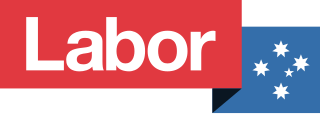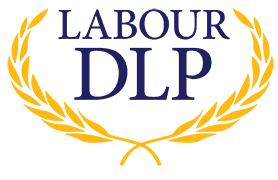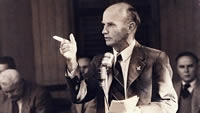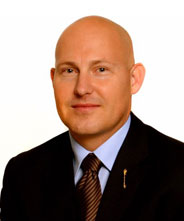
The Australian Labor Party (ALP), also simply known as Labor, is the major centre-left political party in Australia, one of two major parties in Australian politics, along with the centre-right Liberal Party of Australia. The party has been governing federally since being elected at the 2022 election, and with political branches in each state and territory, they are currently in government in New South Wales, Queensland, South Australia, Victoria, Western Australia, the Australian Capital Territory, and the Northern Territory – Tasmania is the only state or territory where they currently form the opposition. It is the oldest political party in Australia, being established on 8 May 1901 at Parliament House, Melbourne, the meeting place of the first federal Parliament.

The White Australia policy is a term encapsulating a set of historical policies that aimed to forbid people of non-European ethnic origin, especially Asians and Pacific Islanders, from immigrating to Australia, starting in 1901. Governments progressively dismantled such policies between 1949 and 1973.

The Democratic Labour Party (DLP), formerly the Democratic Labor Party, is an Australian political party. It broke off from the Australian Labor Party (ALP) as a result of the 1955 ALP split, originally under the name Australian Labor Party (Anti-Communist), and was renamed the Democratic Labor Party in 1957. In 1962, the Queensland Labor Party, a breakaway party of the Queensland branch of the Australian Labor Party, became the Queensland branch of the DLP.

Dick Taverne, Baron Taverne, is a British politician and life peer who served as Member of Parliament (MP) for Lincoln from 1962 to 1974. A member of the Liberal Democrats, he was a Labour MP until his deselection in 1972, following which he resigned his seat and won the subsequent by-election in 1973 as a Democratic Labour candidate.

Edward Granville Theodore was an Australian politician who served as Premier of Queensland from 1919 to 1925, as leader of the state Labor Party. He later entered federal politics, serving as Treasurer in the Scullin Labor government.

Frederick Woolnough Paterson was an Australian politician, activist, unionist and lawyer. He is the only representative of the Communist Party of Australia to be elected to an Australian parliament.

Michael John Ahern is a former Queensland National Party politician who was Premier of Queensland from December 1987 to September 1989. After a long career in the government of Sir Joh Bjelke-Petersen, Ahern became his successor amid the controversy caused by the Fitzgerald Inquiry into official corruption. Ahern's consensus style and political moderation contrasted strongly with Bjelke-Petersen's leadership, but he could not escape the division and strife caused by his predecessor's downfall.

Philip Collier was an Australian politician who served as the 14th Premier of Western Australia from 1924 to 1930 and from 1933 to 1936. He was leader of the Labor Party from 1917 to 1936, and is Western Australia's longest-serving premier from that party.
Ross Andrew Fitzgerald is an Australian academic, historian, novelist, secularist, and political commentator. Fitzgerald is an Emeritus Professor in History and Politics at Griffith University. He has published forty-three books, including three histories of Queensland, two biographies, works about Labor Party politics of the 1950s, with other books relating to philosophy, alcohol and Australian Rules football, as well as eight works of fiction, including seven political/sexual satires about his corpulent anti-hero Professor Dr Grafton Everest.

Curtis Warren Pitt is an Australian politician who has been a Labor Party member of the Legislative Assembly of Queensland since 2009, representing the district of Mulgrave. On 14 February 2015, he was sworn in as Treasurer of Queensland.
Rodney Mark Cavalier is a former Australian politician, statutory officer and author. Cavalier was a member of the New South Wales Legislative Assembly representing Fuller between 1978 and 1981 and then Gladesville between 1981 and 1988 for the Labor Party. During his term in parliament, Cavalier was Minister for Energy, Minister for Finance, and Minister for Education in the Wran and Unsworth governments.
Patrick Leslie Coleman, Australian politician, was a member of the Victorian Legislative Council for Melbourne West Province representing the Labor Party from October 1943 until March 1955. He was a member of the Catholic Social Studies Movement in Victoria, and was expelled from the ministry and the ALP as part of the Australian Labor Party split of 1955. After his expulsion from the ALP in March 1955, he became, with Bill Barry in the Victorian Legislative Assembly, the parliamentary leader of the Australian Labor Party (Anti-Communist), which was briefly referred to in the media as the Coleman-Barry Labor Party. He was a member of that party only until June 1955.
William Peter Barry was a Member of the Victorian Legislative Assembly for the Electoral district of Carlton from July 1932 until April 1955. Barry was a member of the Labor Party until March 1955, when he was expelled from the party as part of the Australian Labor Party split of 1955. He became, with Les Coleman in the Victorian Legislative Council, joint leader of the Australian Labor Party (Anti-Communist), a party that in 1957 became the Democratic Labor Party.
Alan Douglas Joseph Reid, nicknamed the Red Fox, was an Australian political journalist, who worked in the Federal Parliamentary Press Gallery from 1937 to 1985. He is noted for his role in the Australian Labor Party split of 1955 and his coinage of the term "36 faceless men" to describe the members of the Australian Labor Party's Federal Conference.
Fortitude Valley, originally known as Hamlet of Fortitude Valley, was a Legislative Assembly electorate in the state of Queensland.
The history of the Australian Labor Party has its origins in the Labour parties founded in the 1890s in the Australian colonies prior to federation. Labor tradition ascribes the founding of Queensland Labour to a meeting of striking pastoral workers under a ghost gum tree in Barcaldine, Queensland in 1891. The Balmain, New South Wales branch of the party claims to be the oldest in Australia. Labour as a parliamentary party dates from 1891 in New South Wales and South Australia, 1893 in Queensland, and later in the other colonies.
The National Party, later the United Party was a political party in the Australian state of Queensland from 1917 until 1925. Although allied with the federal Nationalist Party, it had different origins in state politics. It sought to combine the state's Liberal Party with the Country Party but the latter soon withdrew. In 1923 the party sought a further unification with the Country Party but only attracted a few recruits. Then in 1925 it merged with the Country Party, initially as the Country Progressive Party with a few members left out and then they were absorbed into the renamed Country and Progressive National Party.
The Kidstonites or Kidston party were a political party in the Australian state of Queensland in 1907 to 1908, formed by William Kidston. The party resulted from a split in the Queensland Labor Party and spent most of its existence in government, before merging with the conservative faction of Robert Philp in October 1908, to form the Liberal Party.
The Liberal Party was a political party in the Australian state of Queensland in the early 20th century. It combined the main non-Labor forces, the "Kidstonites" of William Kidston and the Conservatives of Robert Philp, similar to the federal Commonwealth Liberal Party whose fusion it preceded. The Liberals held government from their formation in 1908 until defeat in 1915 after which they combined with other elements in the state to form the National Party.

The University of Melbourne Australian Labor Party Club is a political student club at the University of Melbourne. It is the oldest student political club in Australia, founded in 1925- several months prior to the Sydney University Labor Club. Many members go on to be members of Parliament. It was founded to provide a means of organising students who support the Australian Labor Party. The club has been hugely influential on the University of Melbourne Student Union, and its members have held numerous positions within it. The club is strongly associated with the Labor Left of the Australian Labor Party.


































